In-depth Analysis: US v. Microsoft Corp. and the US Antitrust Law
VerifiedAdded on 2023/06/13
|5
|1251
|152
Case Study
AI Summary
This case study delves into the United States v. Microsoft Corporation antitrust case, focusing on allegations that Microsoft violated the Sherman Antitrust Act by leveraging its Windows operating system to monopolize the web browser market with Internet Explorer. The plaintiff argued that Microsoft's actions, such as offering Internet Explorer for free and restricting licensing agreements with original equipment manufacturers, hindered competition from browsers like Netscape Navigator and Opera. Microsoft contended that its actions were pro-consumer and within its rights. The court found Microsoft liable for violating antitrust laws, advising the company to modify its policies. This document provides a detailed analysis of the case, including the arguments, key issues, and the court's decision, offering a comprehensive understanding of the implications of antitrust law in the technology sector. Desklib provides a platform for students to access this and other solved assignments for academic support.
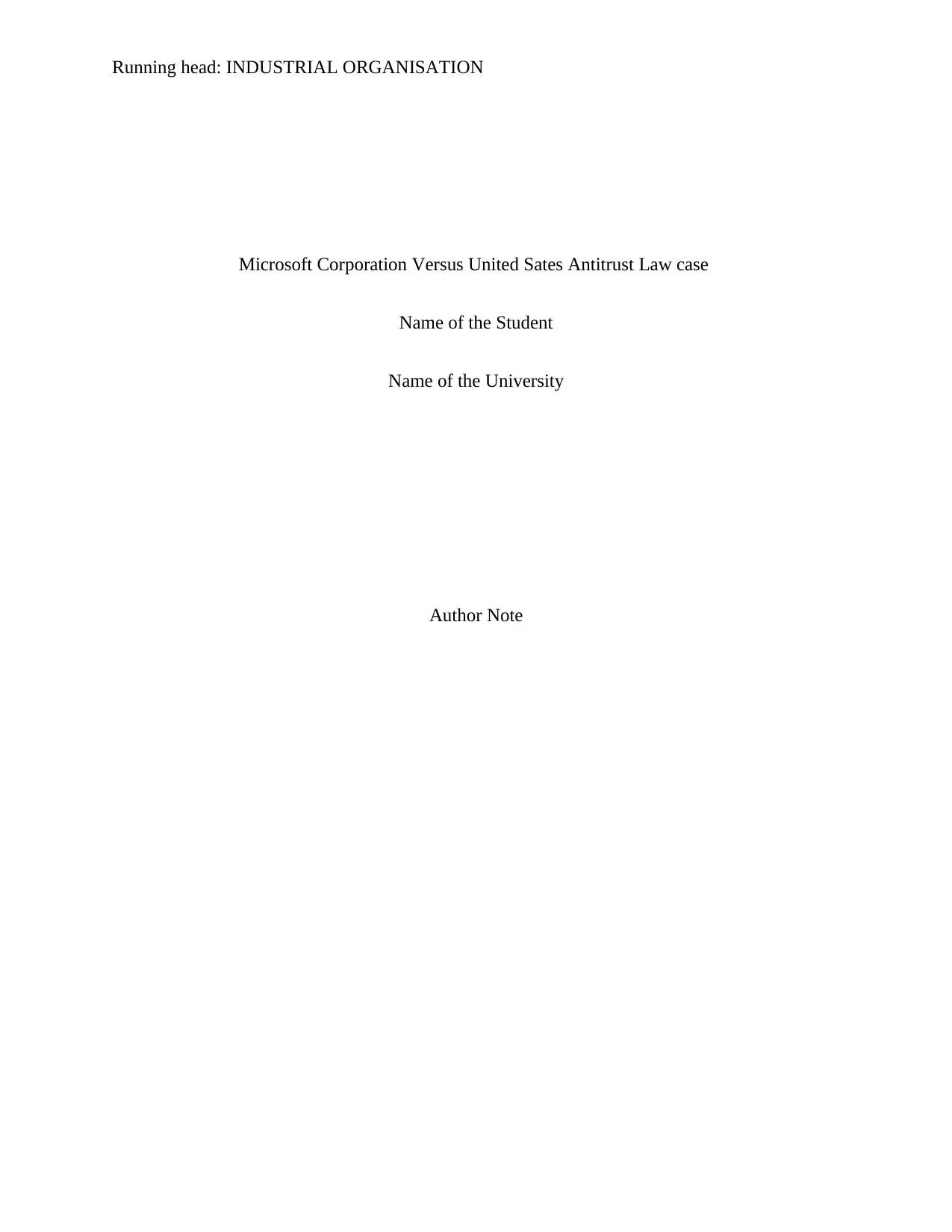
Running head: INDUSTRIAL ORGANISATION
Microsoft Corporation Versus United Sates Antitrust Law case
Name of the Student
Name of the University
Author Note
Microsoft Corporation Versus United Sates Antitrust Law case
Name of the Student
Name of the University
Author Note
Paraphrase This Document
Need a fresh take? Get an instant paraphrase of this document with our AI Paraphraser
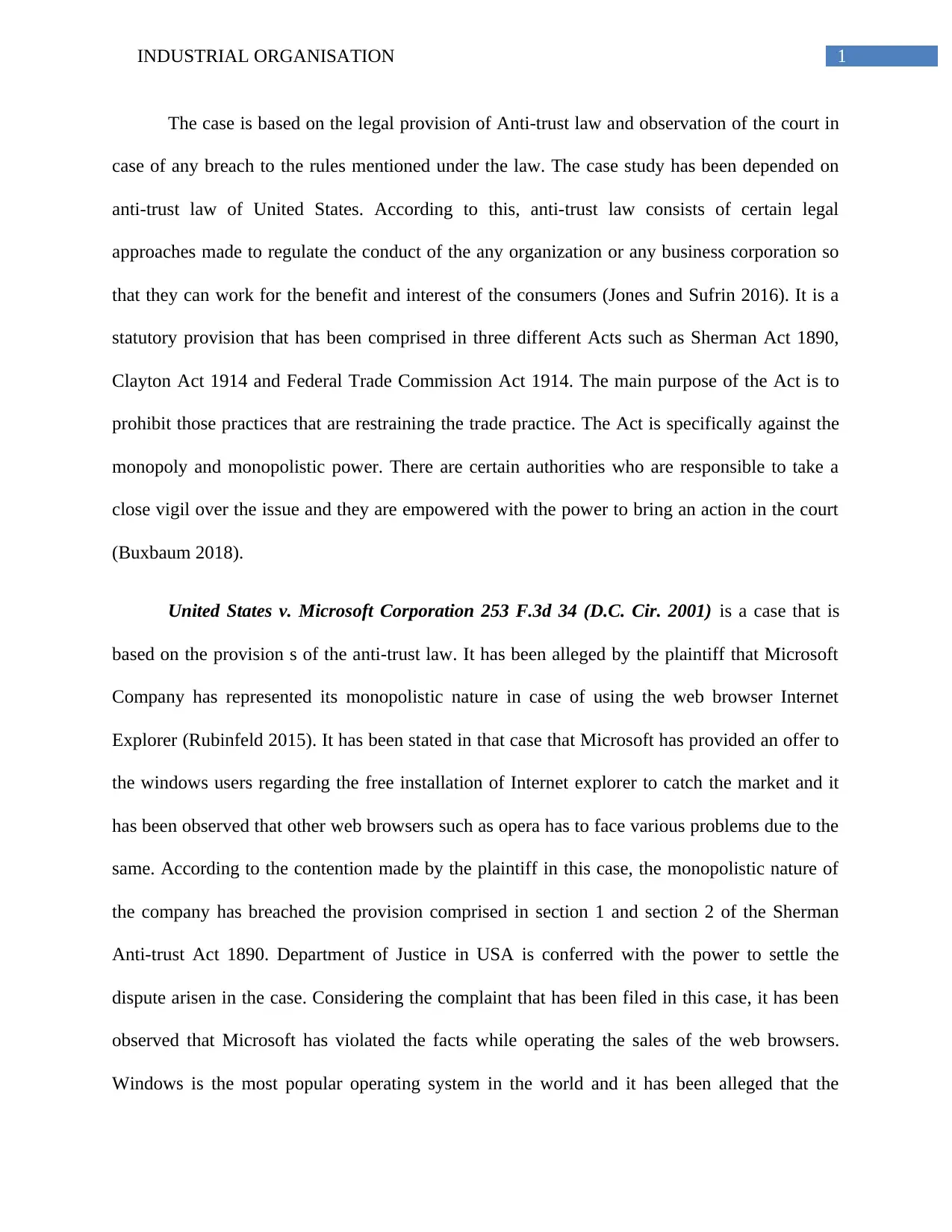
1INDUSTRIAL ORGANISATION
The case is based on the legal provision of Anti-trust law and observation of the court in
case of any breach to the rules mentioned under the law. The case study has been depended on
anti-trust law of United States. According to this, anti-trust law consists of certain legal
approaches made to regulate the conduct of the any organization or any business corporation so
that they can work for the benefit and interest of the consumers (Jones and Sufrin 2016). It is a
statutory provision that has been comprised in three different Acts such as Sherman Act 1890,
Clayton Act 1914 and Federal Trade Commission Act 1914. The main purpose of the Act is to
prohibit those practices that are restraining the trade practice. The Act is specifically against the
monopoly and monopolistic power. There are certain authorities who are responsible to take a
close vigil over the issue and they are empowered with the power to bring an action in the court
(Buxbaum 2018).
United States v. Microsoft Corporation 253 F.3d 34 (D.C. Cir. 2001) is a case that is
based on the provision s of the anti-trust law. It has been alleged by the plaintiff that Microsoft
Company has represented its monopolistic nature in case of using the web browser Internet
Explorer (Rubinfeld 2015). It has been stated in that case that Microsoft has provided an offer to
the windows users regarding the free installation of Internet explorer to catch the market and it
has been observed that other web browsers such as opera has to face various problems due to the
same. According to the contention made by the plaintiff in this case, the monopolistic nature of
the company has breached the provision comprised in section 1 and section 2 of the Sherman
Anti-trust Act 1890. Department of Justice in USA is conferred with the power to settle the
dispute arisen in the case. Considering the complaint that has been filed in this case, it has been
observed that Microsoft has violated the facts while operating the sales of the web browsers.
Windows is the most popular operating system in the world and it has been alleged that the
The case is based on the legal provision of Anti-trust law and observation of the court in
case of any breach to the rules mentioned under the law. The case study has been depended on
anti-trust law of United States. According to this, anti-trust law consists of certain legal
approaches made to regulate the conduct of the any organization or any business corporation so
that they can work for the benefit and interest of the consumers (Jones and Sufrin 2016). It is a
statutory provision that has been comprised in three different Acts such as Sherman Act 1890,
Clayton Act 1914 and Federal Trade Commission Act 1914. The main purpose of the Act is to
prohibit those practices that are restraining the trade practice. The Act is specifically against the
monopoly and monopolistic power. There are certain authorities who are responsible to take a
close vigil over the issue and they are empowered with the power to bring an action in the court
(Buxbaum 2018).
United States v. Microsoft Corporation 253 F.3d 34 (D.C. Cir. 2001) is a case that is
based on the provision s of the anti-trust law. It has been alleged by the plaintiff that Microsoft
Company has represented its monopolistic nature in case of using the web browser Internet
Explorer (Rubinfeld 2015). It has been stated in that case that Microsoft has provided an offer to
the windows users regarding the free installation of Internet explorer to catch the market and it
has been observed that other web browsers such as opera has to face various problems due to the
same. According to the contention made by the plaintiff in this case, the monopolistic nature of
the company has breached the provision comprised in section 1 and section 2 of the Sherman
Anti-trust Act 1890. Department of Justice in USA is conferred with the power to settle the
dispute arisen in the case. Considering the complaint that has been filed in this case, it has been
observed that Microsoft has violated the facts while operating the sales of the web browsers.
Windows is the most popular operating system in the world and it has been alleged that the
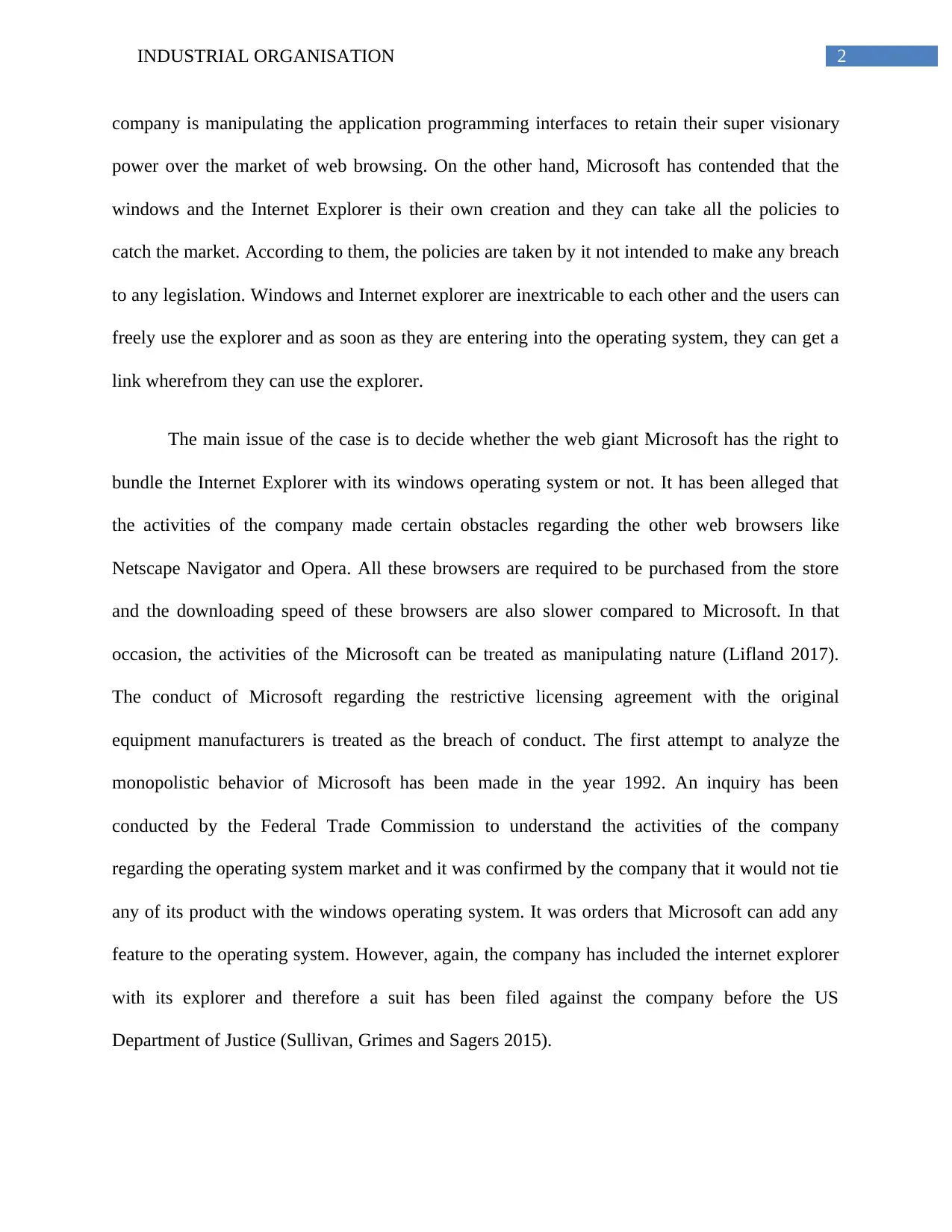
2INDUSTRIAL ORGANISATION
company is manipulating the application programming interfaces to retain their super visionary
power over the market of web browsing. On the other hand, Microsoft has contended that the
windows and the Internet Explorer is their own creation and they can take all the policies to
catch the market. According to them, the policies are taken by it not intended to make any breach
to any legislation. Windows and Internet explorer are inextricable to each other and the users can
freely use the explorer and as soon as they are entering into the operating system, they can get a
link wherefrom they can use the explorer.
The main issue of the case is to decide whether the web giant Microsoft has the right to
bundle the Internet Explorer with its windows operating system or not. It has been alleged that
the activities of the company made certain obstacles regarding the other web browsers like
Netscape Navigator and Opera. All these browsers are required to be purchased from the store
and the downloading speed of these browsers are also slower compared to Microsoft. In that
occasion, the activities of the Microsoft can be treated as manipulating nature (Lifland 2017).
The conduct of Microsoft regarding the restrictive licensing agreement with the original
equipment manufacturers is treated as the breach of conduct. The first attempt to analyze the
monopolistic behavior of Microsoft has been made in the year 1992. An inquiry has been
conducted by the Federal Trade Commission to understand the activities of the company
regarding the operating system market and it was confirmed by the company that it would not tie
any of its product with the windows operating system. It was orders that Microsoft can add any
feature to the operating system. However, again, the company has included the internet explorer
with its explorer and therefore a suit has been filed against the company before the US
Department of Justice (Sullivan, Grimes and Sagers 2015).
company is manipulating the application programming interfaces to retain their super visionary
power over the market of web browsing. On the other hand, Microsoft has contended that the
windows and the Internet Explorer is their own creation and they can take all the policies to
catch the market. According to them, the policies are taken by it not intended to make any breach
to any legislation. Windows and Internet explorer are inextricable to each other and the users can
freely use the explorer and as soon as they are entering into the operating system, they can get a
link wherefrom they can use the explorer.
The main issue of the case is to decide whether the web giant Microsoft has the right to
bundle the Internet Explorer with its windows operating system or not. It has been alleged that
the activities of the company made certain obstacles regarding the other web browsers like
Netscape Navigator and Opera. All these browsers are required to be purchased from the store
and the downloading speed of these browsers are also slower compared to Microsoft. In that
occasion, the activities of the Microsoft can be treated as manipulating nature (Lifland 2017).
The conduct of Microsoft regarding the restrictive licensing agreement with the original
equipment manufacturers is treated as the breach of conduct. The first attempt to analyze the
monopolistic behavior of Microsoft has been made in the year 1992. An inquiry has been
conducted by the Federal Trade Commission to understand the activities of the company
regarding the operating system market and it was confirmed by the company that it would not tie
any of its product with the windows operating system. It was orders that Microsoft can add any
feature to the operating system. However, again, the company has included the internet explorer
with its explorer and therefore a suit has been filed against the company before the US
Department of Justice (Sullivan, Grimes and Sagers 2015).
⊘ This is a preview!⊘
Do you want full access?
Subscribe today to unlock all pages.

Trusted by 1+ million students worldwide
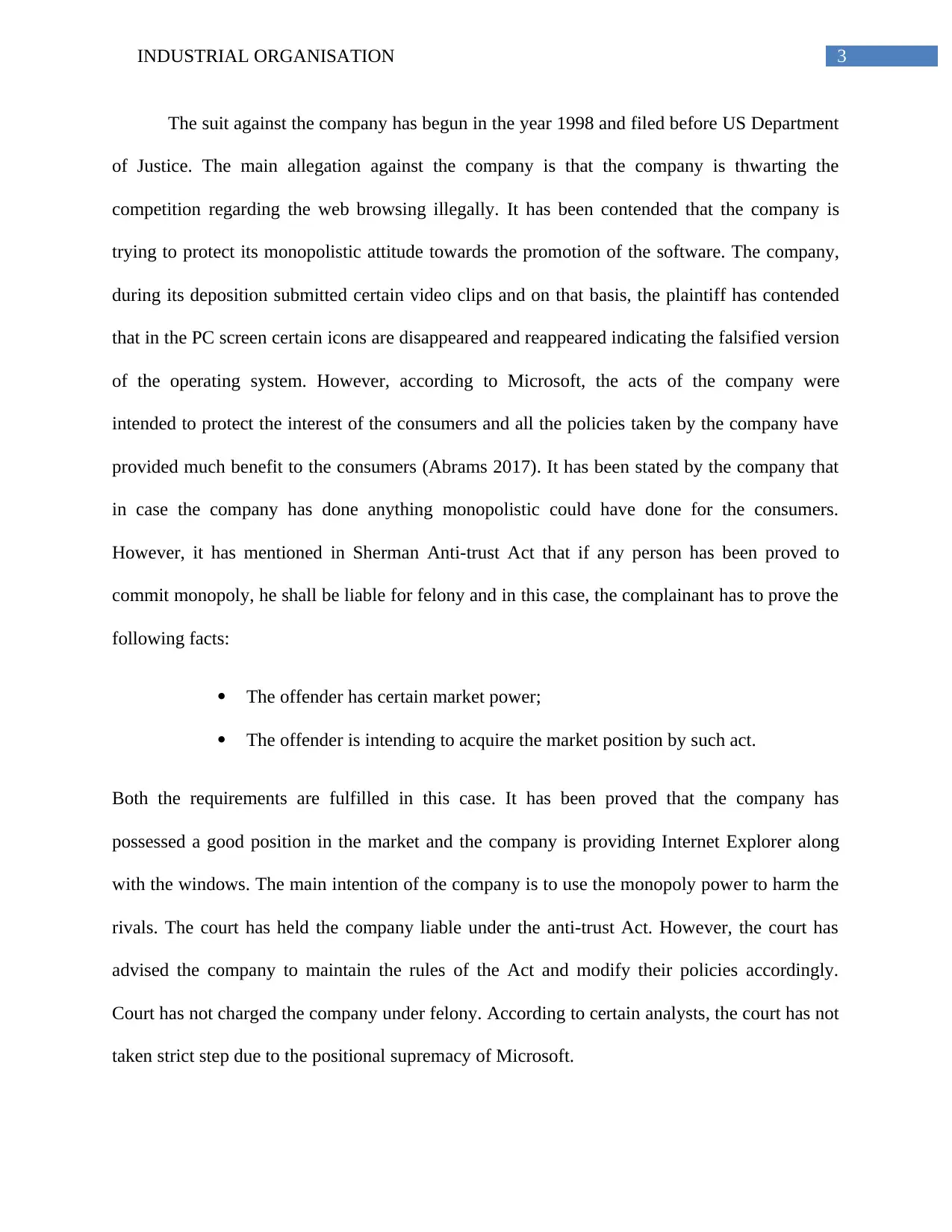
3INDUSTRIAL ORGANISATION
The suit against the company has begun in the year 1998 and filed before US Department
of Justice. The main allegation against the company is that the company is thwarting the
competition regarding the web browsing illegally. It has been contended that the company is
trying to protect its monopolistic attitude towards the promotion of the software. The company,
during its deposition submitted certain video clips and on that basis, the plaintiff has contended
that in the PC screen certain icons are disappeared and reappeared indicating the falsified version
of the operating system. However, according to Microsoft, the acts of the company were
intended to protect the interest of the consumers and all the policies taken by the company have
provided much benefit to the consumers (Abrams 2017). It has been stated by the company that
in case the company has done anything monopolistic could have done for the consumers.
However, it has mentioned in Sherman Anti-trust Act that if any person has been proved to
commit monopoly, he shall be liable for felony and in this case, the complainant has to prove the
following facts:
The offender has certain market power;
The offender is intending to acquire the market position by such act.
Both the requirements are fulfilled in this case. It has been proved that the company has
possessed a good position in the market and the company is providing Internet Explorer along
with the windows. The main intention of the company is to use the monopoly power to harm the
rivals. The court has held the company liable under the anti-trust Act. However, the court has
advised the company to maintain the rules of the Act and modify their policies accordingly.
Court has not charged the company under felony. According to certain analysts, the court has not
taken strict step due to the positional supremacy of Microsoft.
The suit against the company has begun in the year 1998 and filed before US Department
of Justice. The main allegation against the company is that the company is thwarting the
competition regarding the web browsing illegally. It has been contended that the company is
trying to protect its monopolistic attitude towards the promotion of the software. The company,
during its deposition submitted certain video clips and on that basis, the plaintiff has contended
that in the PC screen certain icons are disappeared and reappeared indicating the falsified version
of the operating system. However, according to Microsoft, the acts of the company were
intended to protect the interest of the consumers and all the policies taken by the company have
provided much benefit to the consumers (Abrams 2017). It has been stated by the company that
in case the company has done anything monopolistic could have done for the consumers.
However, it has mentioned in Sherman Anti-trust Act that if any person has been proved to
commit monopoly, he shall be liable for felony and in this case, the complainant has to prove the
following facts:
The offender has certain market power;
The offender is intending to acquire the market position by such act.
Both the requirements are fulfilled in this case. It has been proved that the company has
possessed a good position in the market and the company is providing Internet Explorer along
with the windows. The main intention of the company is to use the monopoly power to harm the
rivals. The court has held the company liable under the anti-trust Act. However, the court has
advised the company to maintain the rules of the Act and modify their policies accordingly.
Court has not charged the company under felony. According to certain analysts, the court has not
taken strict step due to the positional supremacy of Microsoft.
Paraphrase This Document
Need a fresh take? Get an instant paraphrase of this document with our AI Paraphraser
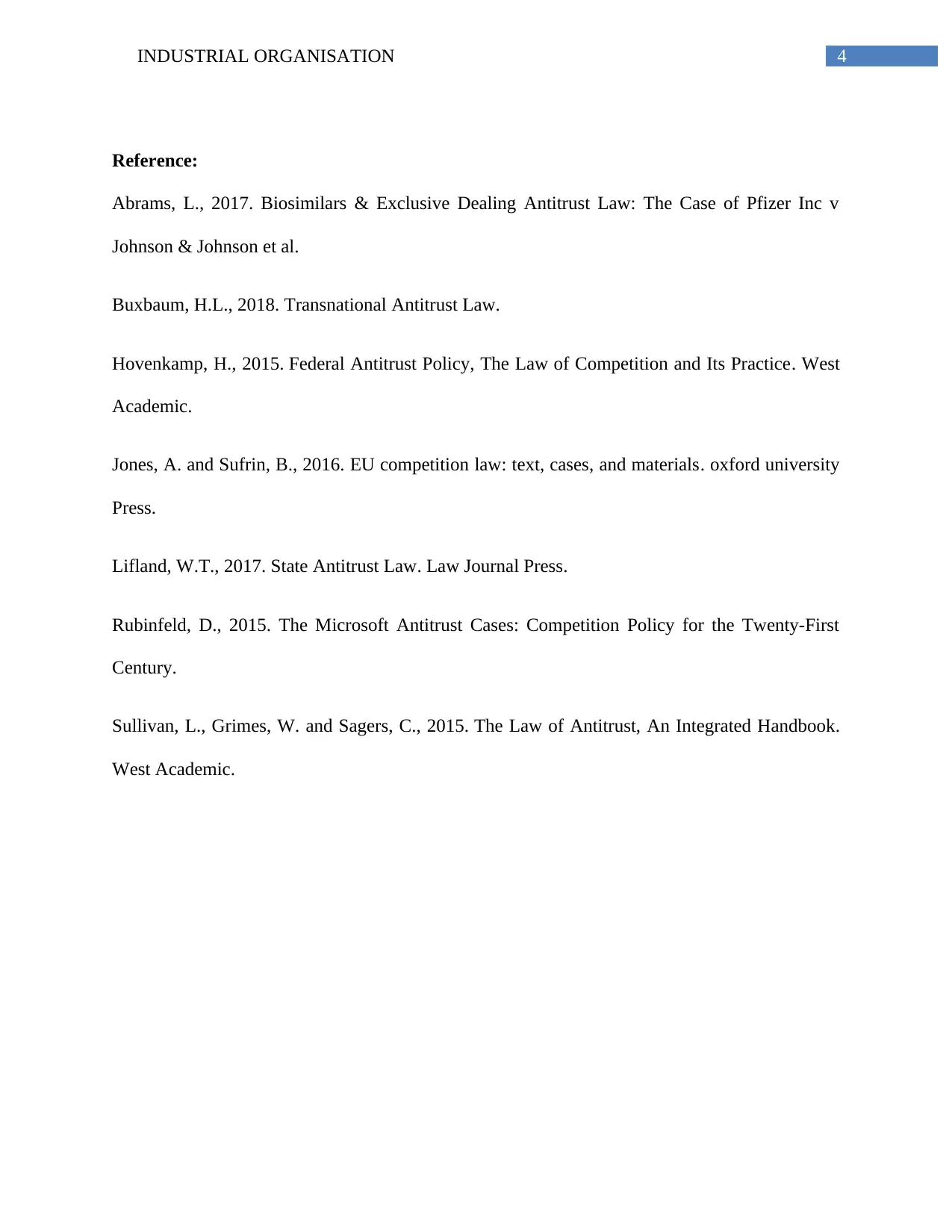
4INDUSTRIAL ORGANISATION
Reference:
Abrams, L., 2017. Biosimilars & Exclusive Dealing Antitrust Law: The Case of Pfizer Inc v
Johnson & Johnson et al.
Buxbaum, H.L., 2018. Transnational Antitrust Law.
Hovenkamp, H., 2015. Federal Antitrust Policy, The Law of Competition and Its Practice. West
Academic.
Jones, A. and Sufrin, B., 2016. EU competition law: text, cases, and materials. oxford university
Press.
Lifland, W.T., 2017. State Antitrust Law. Law Journal Press.
Rubinfeld, D., 2015. The Microsoft Antitrust Cases: Competition Policy for the Twenty-First
Century.
Sullivan, L., Grimes, W. and Sagers, C., 2015. The Law of Antitrust, An Integrated Handbook.
West Academic.
Reference:
Abrams, L., 2017. Biosimilars & Exclusive Dealing Antitrust Law: The Case of Pfizer Inc v
Johnson & Johnson et al.
Buxbaum, H.L., 2018. Transnational Antitrust Law.
Hovenkamp, H., 2015. Federal Antitrust Policy, The Law of Competition and Its Practice. West
Academic.
Jones, A. and Sufrin, B., 2016. EU competition law: text, cases, and materials. oxford university
Press.
Lifland, W.T., 2017. State Antitrust Law. Law Journal Press.
Rubinfeld, D., 2015. The Microsoft Antitrust Cases: Competition Policy for the Twenty-First
Century.
Sullivan, L., Grimes, W. and Sagers, C., 2015. The Law of Antitrust, An Integrated Handbook.
West Academic.
1 out of 5
Your All-in-One AI-Powered Toolkit for Academic Success.
+13062052269
info@desklib.com
Available 24*7 on WhatsApp / Email
![[object Object]](/_next/static/media/star-bottom.7253800d.svg)
Unlock your academic potential
Copyright © 2020–2025 A2Z Services. All Rights Reserved. Developed and managed by ZUCOL.